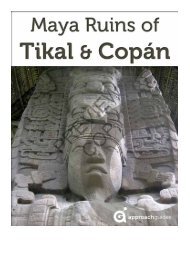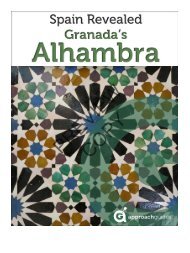The Temples of Bangkok - Approach Guides
The Temples of Bangkok - Approach Guides
The Temples of Bangkok - Approach Guides
You also want an ePaper? Increase the reach of your titles
YUMPU automatically turns print PDFs into web optimized ePapers that Google loves.
Layout and Appearance<br />
• Dual vihans (yellow highlights in Fig. 56) afford access from the east. Visitors enter the<br />
complex by walking between them.<br />
• A massive, central prang (red highlights in Fig. 56; also see Fig. 57) sits atop three aggressively<br />
redented, octagonal terraces. <strong>The</strong> prang is topped by Indra’s weapon, the<br />
vajra (thunderbolt); the vajra symbolically shatters illusion, thereby enabling the faithful to<br />
achieve enlightenment.<br />
• Four mandapa pavilions (green highlights in Fig. 56), aligned with the cardinal points,<br />
sit at the base <strong>of</strong> staircases that rise to the upper terrace.<br />
• <strong>The</strong> central prang is surrounded by four smaller, similarly-shaped prangs (also in red<br />
highlights in Fig. 56) on the intra-cardinal directions, forming a Khmer-inspired quincunx<br />
arrangement.<br />
<strong>The</strong> Prang<br />
While its general appearance and quincunx arrangement are tightly grounded in Late Ayutthaya architectural<br />
precedent, Wat Arun’s prang achieves a new level <strong>of</strong> refinement; it is the most<br />
distinctively Thai manifestation <strong>of</strong> this architectural form (see Fig. 57). It has two defining<br />
features that separate it from all prangs that came before it:<br />
• Wat Arun’s tower is markedly thinner than those <strong>of</strong> all prior Ayutthaya prangs, which<br />
tended to assume more bulbous proportions, in line with Khmer prototypes.<br />
• It also has an even more pronounced vertical orientation, as the square terraces on<br />
which it sits are taller and even more aggressively redented; in this manifestation, the base<br />
has seamlessly integrated with the prang tower it supports.<br />
To contextualize the magnitude <strong>of</strong> these two changes, see the comparison in Fig. 57 <strong>of</strong> Wat Arun<br />
with the Late Ayutthaya period prang <strong>of</strong> Wat Chai Watthanaram (built 1630) in Ayutthaya.








